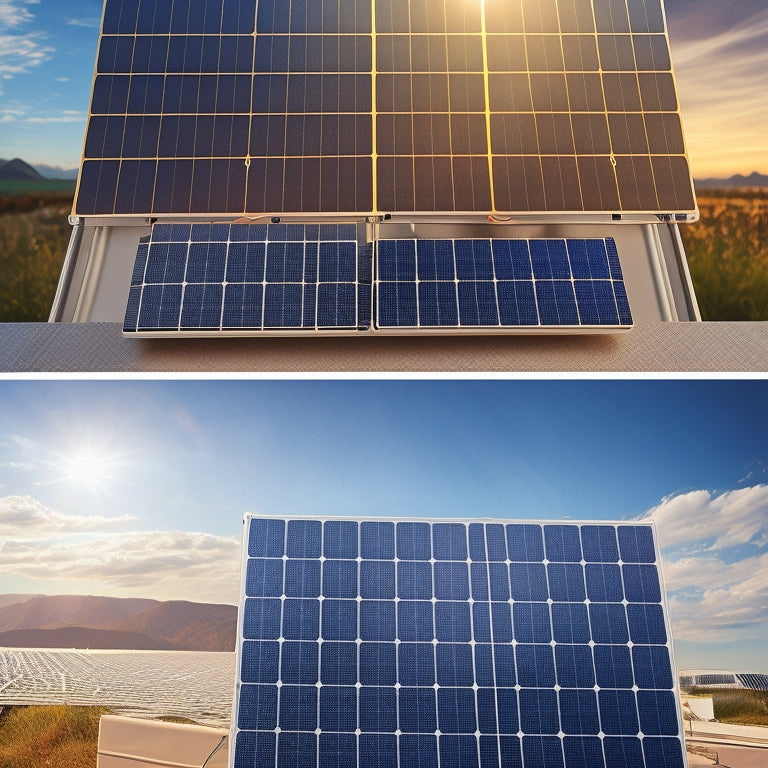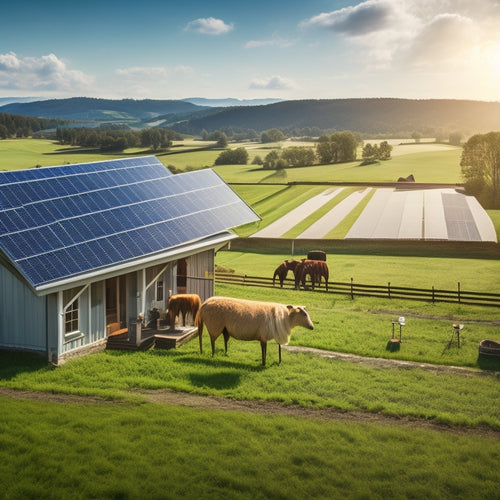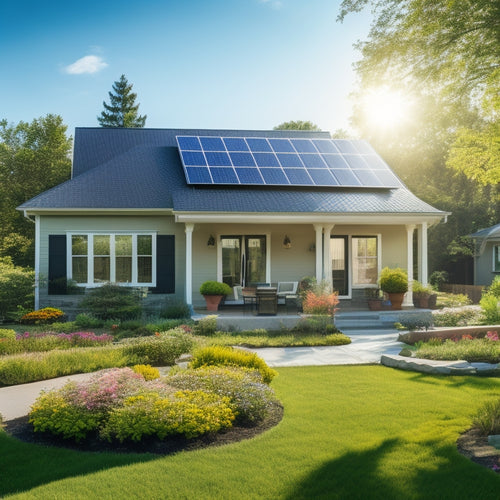
Difference Between Photoelectric Panels and Solar Panels
Share
You're likely exploring alternative energy options and wondering what sets photoelectric panels apart from traditional solar panels. Photoelectric panels boast a higher conversion efficiency rate of 15% to 20%, whereas solar panels average 10% to 15%. This difference stems from the advanced technologies used in photoelectric panels, like gallium arsenide, which enables better energy absorption. Additionally, photoelectric panels capture higher-frequency radiation, such as UV and X-rays, whereas solar panels optimize absorption of lower-frequency radiation. As you consider your energy needs, understanding these distinctions will help you make an informed decision - and there's more to uncover about these clean energy solutions.
Key Takeaways
- Photoelectric panels have a higher conversion efficiency rate (15%-20%) compared to solar panels (10%-15%) due to advanced technologies like gallium arsenide.
- Photoelectric panels are ideal for small-scale applications, while solar panels are more suited for large-scale energy generation due to their lower cost.
- Photoelectric panels capture higher-frequency radiation like UV and X-rays, whereas solar panels optimize absorption of lower-frequency radiation including visible and infrared light.
- Photoelectric panels require a higher initial investment but offer long-term savings, whereas solar panels require more frequent cleaning and maintenance with a shorter lifespan.
- Solar panels tend to have a lower environmental impact throughout their lifecycle compared to photoelectric panels, which require larger areas and generate more hazardous waste.
Panel Conversion Efficiency Rates
When it comes to utilizing energy from the sun, both photoelectric panels and solar panels rely on converting sunlight into electrical energy. However, their panel efficiency rates differ greatly.
You'll find that photoelectric panels have a higher conversion efficiency rate, typically ranging from 15% to 20%. This is because they use advanced conversion technologies, such as gallium arsenide, to maximize energy absorption.
In contrast, solar panels have a lower efficiency rate, usually between 10% to 15%. This is due to their reliance on silicon-based cells, which are less effective at converting sunlight into electricity.
Despite these differences, both panels have their advantages. Photoelectric panels are ideal for small-scale applications, such as powering individual homes or electronic devices.
Solar panels, on the other hand, are more suitable for large-scale energy generation, like powering entire communities or industrial facilities.
Energy Generation Principles
You're about to investigate the energy generation principles that make photoelectric panels and solar panels tick.
When light energy hits these panels, it triggers a photovoltaic cell reaction that converts light into electrical energy.
This process relies on the absorption of electromagnetic radiation, which is then utilized to generate power.
Light Energy Conversion
Light Energy Conversion
Photons striking a photovoltaic material trigger the process of light energy conversion, where photons are absorbed, exciting electrons that then flow through a circuit to generate electricity. You're fundamentally leveraging the power of light to produce electrical energy. This conversion process occurs in both photoelectric panels and solar panels, but the methods differ.
| Conversion Method | Description |
|---|---|
| Photovoltaic Effect | Photons excite electrons, which flow through a circuit to generate electricity |
| Photochemical Effect | Light energy triggers a chemical reaction, producing electricity |
| Thermo-Photovoltaic Effect | Light energy heats a material, generating electricity through thermoelectric conversion |
When it comes to conversion methods, photoelectric panels rely on the photovoltaic effect, whereas solar panels can employ any of the above methods. The choice of conversion method depends on the specific application and desired output. As you investigate the differences between photoelectric panels and solar panels, understanding light energy conversion is vital in determining which technology best suits your energy needs.
Photovoltaic Cell Reaction
Your photovoltaic cell's reaction is the heart of energy generation, where the photovoltaic effect takes center stage. This process relies on the interaction between light and the semiconductor material used in your solar panel. The reaction involves the conversion of light energy into electrical energy.
When light hits your photovoltaic cell, it excites the electrons in the material, allowing them to flow freely. This flow of electrons is what generates electricity. The type of photovoltaic cell and its material properties play a significant role in this process.
Here are some key factors that influence the photovoltaic cell reaction:
-
Photovoltaic cell types: There are several types of photovoltaic cells, including monocrystalline, polycrystalline, and thin-film cells. Each type has its own unique characteristics and efficiency rates.
-
Solar cell materials: The semiconductor material used in your solar panel, such as silicon, affects the reaction. Different materials have varying energy conversion rates and efficiencies.
-
Light intensity: The amount of light that hits your photovoltaic cell impacts the reaction. Higher light intensities can increase energy generation.
- Temperature: The operating temperature of your solar panel also affects the reaction, with ideal temperatures ranging between 59°F and 95°F (15°C and 35°C).
Electromagnetic Radiation Absorption
The photovoltaic cell reaction relies on the conversion of light energy into electrical energy, and this process is made possible by the absorption of electromagnetic radiation.
When you consider the various types of radiation, you'll find that photoelectric panels and solar panels respond differently to each. Photoelectric panels are designed to capture the energy from higher-frequency radiation, such as ultraviolet (UV) and X-rays, which trigger the photoelectric effect. This effect occurs when high-energy photons liberate electrons from the material, generating an electric current.
In contrast, solar panels are optimized for absorbing lower-frequency radiation, including visible and infrared light. These panels convert the energy from photons into electrical energy through the photovoltaic effect.
The absorption of electromagnetic radiation is critical for both types of panels, as it enables the conversion of light energy into electrical energy. By understanding the differences in radiation absorption, you can better appreciate the unique characteristics of photoelectric panels and solar panels, ultimately making informed decisions about which technology is best suited for your energy needs.
Cost and Maintenance Comparison
Its cost and maintenance requirements are essential factors to evaluate when deciding between photoelectric panels and solar panels. As you weigh your options, consider the following key aspects:
-
Initial Investment: Photoelectric panels typically require a higher initial investment due to their complex technology and higher production costs. Solar panels, on the other hand, are more affordable upfront.
-
Long-term Savings: Although photoelectric panels are more expensive initially, they can provide higher energy outputs, leading to greater long-term savings. Solar panels, while cheaper upfront, may not generate as much energy over time.
-
Maintenance Frequency: Solar panels require more frequent cleaning and maintenance to guarantee peak energy production. Photoelectric panels, with their simpler design, need less upkeep.
- Replacement Cycle: Solar panels usually have a shorter lifespan (around 25 years) and need to be replaced more frequently. Photoelectric panels, with their more durable design, can last up to 40 years or more.
Environmental Impact Analysis
As you investigate the environmental impact of photoelectric panels and solar panels, reflect that both alternatives have distinct ecological consequences.
A sustainability assessment reveals that both options have a significant impact on the environment, but in different ways.
| Environmental Impact | Photoelectric Panels | Solar Panels |
| Land Use | Require large areas for installation | Require smaller areas for installation |
| Greenhouse Gas Emissions | Produce some emissions during manufacturing | Produce minimal emissions during manufacturing |
| Water Usage | Consume water for cleaning and cooling | Consume minimal water for cleaning |
| Waste Generation | Generate hazardous waste during disposal | Generate minimal waste during disposal |
When evaluating the ecological footprint of both alternatives, it's crucial to examine the entire lifecycle of each technology, from production to disposal.
While both options have their drawbacks, solar panels tend to have a lower environmental impact overall.
However, photoelectric panels can still be a viable option in certain situations, such as in areas with limited sunlight.
Ultimately, the choice between photoelectric panels and solar panels depends on your specific needs and priorities.
Installation and Mounting Options
You've evaluated the environmental impact of photoelectric panels and solar panels, now it's time to investigate how you'll integrate these technologies into your space.
When it comes to installation and mounting options, you'll want to choose the right techniques to guarantee maximum energy output and durability.
Here are some key installation techniques and mounting systems to take into account:
-
Roof-mounted systems: Ideal for residential and commercial buildings, these systems are attached directly to your roof.
-
Ground-mounted systems: Suitable for larger spaces, these systems are installed on the ground and can be adjusted to optimize energy production.
-
Tracking systems: These systems allow your panels to move with the sun, increasing energy output by up to 45%.
- Ballasted systems: A non-penetrating option that uses weights to secure the panels, ideal for rooftops with weight restrictions.
When selecting an installation technique and mounting system, think about factors such as your building's design, local building codes, and energy output requirements.
Applications and Industry Uses
You'll find photoelectric panels and solar panels being used in various applications, from residential power solutions to industrial energy systems.
In residential settings, these panels can power individual homes or entire communities.
In industrial settings, they're used to fuel manufacturing processes and power entire facilities.
Residential Power Solutions
In residential areas, where energy demands are increasing exponentially, solar power has emerged as a viable alternative to traditional fossil fuels, driving the adoption of photoelectric panels and solar panels as a clean and sustainable source of energy.
As you consider switching to renewable energy for your home, you'll want to investigate the benefits of photoelectric panels and solar panels.
Here are some key applications and industry uses:
-
Reduced energy bills: By utilizing sunlight, you can greatly lower your energy costs and enjoy long-term savings.
-
Increased property value: Installing photoelectric panels or solar panels can enhance your property's value and appeal to potential buyers.
-
Sustainable living: You'll be contributing to a cleaner environment and reducing your carbon footprint, which is essential for a sustainable future.
- Government incentives: Many governments offer rebates and tax credits for homeowners who invest in renewable energy solutions.
Industrial Energy Systems
Industrial-scale operations require massive amounts of energy to power their machinery, lighting, and heating/cooling systems. You need a reliable and efficient energy source to keep your production lines running smoothly. This is where photoelectric panels and solar panels come into play.
Both technologies can be used to generate electricity for industrial applications, but they've different strengths and weaknesses.
Photoelectric panels are well-suited for industrial applications that require a high power output. They can be used to power heavy machinery, lighting systems, and HVAC systems. Additionally, photoelectric panels can be used for energy storage, allowing you to store excess energy generated during the day for use during periods of low sunlight or at night.
Solar panels, on the other hand, are ideal for industrial applications that require a lower power output. They can be used to power smaller machinery, lighting systems, and monitoring systems.
Solar panels are also well-suited for remote industrial sites where traditional energy infrastructure isn't available. By leveraging both photoelectric and solar panels, you can create a hybrid energy system that meets your industrial energy needs while reducing your carbon footprint.
Frequently Asked Questions
Can Photoelectric Panels Be Used for Indoor Lighting Purposes?
You can employ photoelectric panels for indoor lighting purposes, capturing natural light through windows or skylights to generate electricity, increasing energy efficiency in indoor applications, while reducing your reliance on traditional power sources.
Do Solar Panels Work During Nighttime or Low-Light Conditions?
You'll find that solar panels don't generate power during nighttime, but their low light performance is decent; however, their nighttime efficiency is zero, as they rely on sunlight to produce electricity, making them ineffective in dark conditions.
Are Photoelectric Panels More Durable Than Solar Panels?
You'll find that photoelectric panels, made with more durable materials, offer superior material resilience, reducing environmental impact through prolonged lifespan and minimized waste, making them a more sustainable option for your power needs.
Can I Install Photoelectric Panels on a Moving Object Like a Car?
You can install photoelectric panels on a car, but consider the panel's size, weight, and photoelectric efficiency to guarantee it generates sufficient car energy; also, confirm secure mounting to withstand vibrations and movement.
Are There Any Government Incentives for Using Photoelectric Panels?
As you electrify your ride, a pot of gold awaits: you're eligible for government incentives, like rebates and tax credits, that'll offset the installation cost of photoelectric panels, making your eco-friendly move a smart financial play too.
Conclusion
As you stand amidst a sea of panels, the sun's warm rays dancing across their surfaces, you're left with an essential decision: photoelectric or solar? The choice isn't just about utilizing the power of the sun, but about efficiency, cost, and environmental impact. By understanding the subtleties between photoelectric and solar panels, you'll reveal the key to a brighter, more sustainable future. The path ahead is clear, illuminated by the promise of renewable energy, waiting for you to access its limitless potential.
Related Posts
-

Solar Power Backup Solutions During Outages
Solar power backup solutions guarantee you have reliable energy during outages, providing essential power when the gr...
-

Solar Power Systems for Rural Properties
Solar power systems offer a reliable and efficient energy solution for rural properties, allowing you to gain energy ...
-

Affordable Solar Panels for Home Use
Affordable solar panels offer you a smart way to cut down on energy costs while promoting sustainability. With govern...


